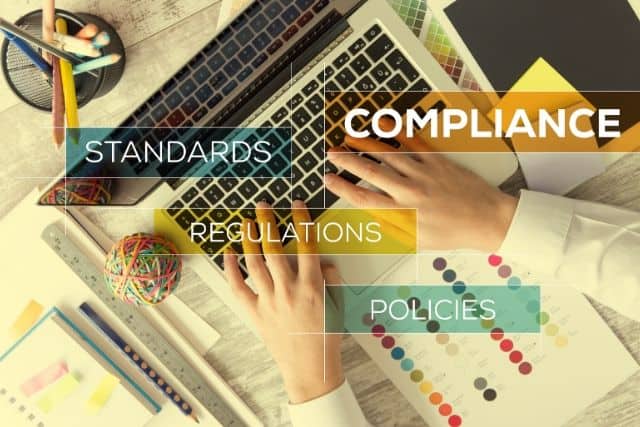How To Create A Corporate Compliance Program
Compliance has long been a hot topic in the corporate world. With new laws such as GDPR, HIPAA, and CCPA being introduced, many companies are rushing to ensure that their operations are compliant with an evolving regulatory environment. Adhering to current rules and regulations is critical for any business that’s looking for longevity and growth.
Unfortunately, many companies find themselves in violation of various laws because they don’t have a robust framework for monitoring compliance. Indeed, compliance is a daily responsibility that begins with each employee and ends with oversight from the management team.
For your business to truly maintain compliance with all relevant industry regulations, you’ll need to create a compliance program. The primary purpose of a compliance program is to detect and prevent mistakes, manage risks that may occur in your business, and enlighten employees on their specific roles within the organization.
As the regulatory environment continues to become more complex, businesses are faced with the challenge of remaining compliant with multiple rules and regulations. Some laws govern data management, vendors, customers, financial transactions, and much more. Therefore, keeping up with all these requirements will necessitate a reliable system that helps you coordinate activities across the entire organization.
Being non-compliant in today’s business environment is not an option. You can face costly fines, a damaged reputation, and loss of customer trust. Furthermore, the social media era can fan the flames of a scandal in just a matter of minutes.
A corporate compliance program allows your company to document all relevant activities as proof of adherence to current regulations. You will also be able to train your workforce on the significance of compliance during daily operations. Finally, a compliance program enables your business to remain agile and responsive to changes in the regulatory environment.
With an effective compliance program, your business will be able to assure both internal and external stakeholders that all activities are being carried out in line with current laws.
Steps to Creating a Corporate Compliance Program
If you’re looking to implement a compliance program for your organization, you may be wondering where to start. There is no one-size-fits-all approach to compliance, meaning that the type of program you implement will depend on the industry, size, and risk profile of your business.
An effective compliance program cuts through lengthy processes, internal department procedures, and corporate governance. It’s all about optimizing your daily workforce to adhere to current laws set forth by the relevant institutions. To help you get started on the right foot, here are critical steps you should take when creating a corporate compliance program.
1. Consider Your Intended Results
Even before jumping into the policies, structures, and procedures that you need to establish compliance, you should first reflect on your intended results. What are you looking to achieve with this compliance program? Which specific risks are you trying to avoid during the process?
For example, your organization may be attempting to adjust its data collection policies to fall in line with CCPA guidelines. To achieve this goal, you’ll need to implement new data processing workflows that promote transparency and accessibility for your customers. These new workflows will make it easier for you to demonstrate compliance with CCPA data security guidelines.
By focusing on the goals of your compliance program, you can develop an effective, objective, and reliable framework for remaining compliant within a rapidly evolving regulatory environment.
2. Involve Management and Stakeholders
Being non-compliant with established laws and safety practices can result in significant consequences. From financial loss to injuries, data breaches, and reputation damage, your operations could potentially become crippled by failing to comply with current regulations. However, many leaders within companies tend to delegate compliance to junior staff. When management doesn’t set the tone for compliance, other employees will also take a back seat when it comes to following these requirements.
Organizational leaders should be directly involved in all compliance-related activities. They should be in the front lines when it comes to establishing structures, processes, and workflows that directly impact the success of an organization’s compliance program. Furthermore, management should spark debate in compliance by talking and writing about these topics.
By setting a positive example through their daily behavior, organizational leaders can spark a culture of compliance within their organizations and avoid falling into the trap of risks and fines.
3. Have an Oversight Team in Place
To bridge the gap between employees and management, your compliance program should have an oversight team in place. The oversight team will provide resources to various stakeholders for required activities while supervising employees to ensure that they carry out their responsibilities in line with company expectations. The oversight team should also report regularly to management about current challenges, loopholes, and resource shortages.
An excellent example of oversight comes during GDPR compliance. Because GDPR is designed to provide security and transparency in customer data, your oversight team will play a critical role when ensuring that consent, data management, and auditing guidelines are being strictly adhered to at all times.
4. Carry out a Risk Assessment
Your corporate compliance program wouldn’t be complete without a risk assessment. Risk assessment involves identifying, evaluating, and mitigating potential risks that might occur within your organization. During this process, you should include a thorough analysis of your business environment, vendors, industry, and government regulations.
A risk assessment allows you to understand the impact that potential threats could cause while prioritizing and managing the most urgent risks. Indeed, having a solid grasp of your risk environment is one of the best ways of ensuring the objectivity of your compliance program.
5. Develop a Risk Management Plan
As part of compliance, you also need to have a strategy for managing the current risks that you face. Risk management is a robust process that involves identifying threats to operational stability, aligning these threats to your business objectives, and developing specific steps that can address your risk environment. Some of these steps include purchasing insurance coverage, transferring risk to a third party vendor, and developing a disaster response strategy.
6. Training Personnel on Maintaining Compliance
A corporate compliance program will only be as effective as how it’s being implemented. Your employees will be at the forefront of putting your plans into action daily. Therefore, training staff on current guidelines, risks, and consequences of non-compliance will be critical.
Every worker should know their role in protecting the company from violations and threats. In this way, you’ll be able to maintain an auditable trail of compliance from the bottom to the top of your organization.
7. Timely Reporting
Speaking of audit trails, your compliance program should include robust reporting so you can provide evidence of compliance when needed. Implement a documentation trail (preferably using the software) that can be verified by both internal and external stakeholders. Detailed reports make auditing more straightforward, and you can provide proof of compliance during a specific period.
Reports are also a resource that you can use to measure performance while implementing a plan for continuous improvement.






